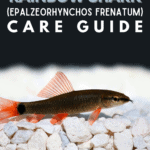The Rainbow shark (Epalzeorhynchos frenatum) is an active, colorful freshwater fish that can make an impressive addition to a large community tank.
But are Rainbow sharks aggressive? What size do Rainbow sharks reach? And what’s the typical lifespan of these fish?
Read this guide to learn how to care for these amazing tropical fish and find out why they are so popular in the aquarium hobby!
What Is A Rainbow Shark?
The Rainbow shark is an aggressive aquarium freshwater fish that many people add to their collections for its beauty and tank-cleaning reputation.
Scientific Name
Epalzeorhynchos frenatum
Common Name (species)
Rainbow Shark, Ruby Shark, Rainbow Sharkminnow, Green Fringelip Labeo, Red-finned Shark, Red-fin Shark, Whitefin Shark, Whitetail Sharkminnow
Family
Cyprinidae
Origin
Indochina, specifically Chao Phraya, Mekong, Maeklong, and Xe Bangai
Diet
Omnivorous
Care Level
Experienced aquarists
Activity
Active
Lifespan
5 to 8 years
Temperament
Semi-aggressive fish species
Tank Level
Bottom-dweller
Minimum Tank Size
50 gallons
Temperature Range
75° to 81° F
Water Hardness
5 – 11 dGH
pH Range
6.5 to 7.5
Filtration/Flow Rate
Moderate
Water type
Freshwater
Breeding
Egg layer
Compatibility
Can live in a spacious community tank
OK, for Planted Tanks?
Yes
History Of Rainbow Sharks
The Rainbow shark (Epalzeorhynchos frenatum) comes from the tropical waters of Chao Phraya, Mekong, Bangfai, and Maeklong basins of Indochina.
Unfortunately, the Rainbow shark’s numbers are decreasing in the wild, largely because of habitat destruction. However, the fish is noted as being of “least concern” on the IUCN Red List.
Fortunately, most of the specimens for sale in fish stores are bred on commercial farms rather than taken from the wild.
Natural Habitat
Rainbow sharks are bottom-dwellers inhabiting sandy-bottomed rivers, where they feed on plankton and algae. During the wet season, the fish migrate to flooded areas, returning to the river once the floods recede.
Physical Characteristics
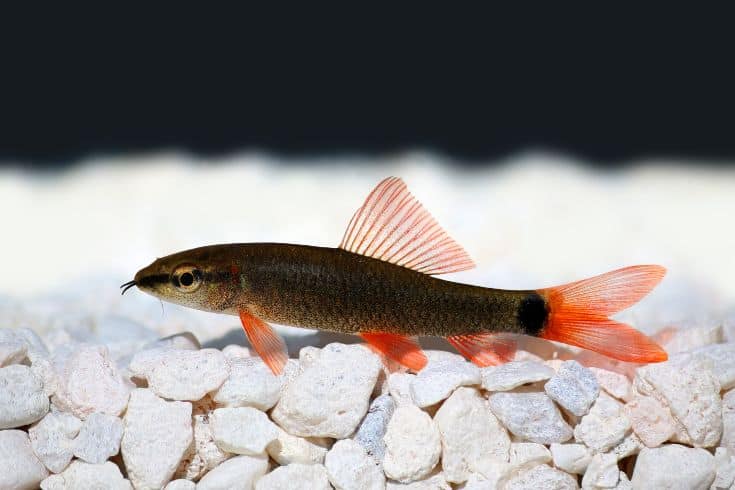
Rainbow sharks are one of several species of freshwater aquarium sharks that are extremely popular with aquarists, despite their semi-aggressive nature.
Size and Coloration
Rainbow sharks are large fish, growing to measure around 6 inches in length when mature.
These are beautiful fish with dark gray bodies and vibrant orange-red fins. The fish are long and flat-bellied with pointed snouts and characteristic upright dorsal fins, giving them the appearance of a shark, hence their NameName.
Generally, male fish have brighter colors than female Rainbow sharks and have thin black lines on their tail fin. In addition, males are more slim-bodied fish than females, which typically have thicker bodies.
Other color variations of this popular freshwater fish include the Albino Rainbow shark, which has orange finnage and a white body.
Average Lifespan In Captivity
Rainbow sharks have a lifespan of between five and eight years in captivity.
Activity Level and Behavior
Rainbow sharks are active bottom-dwellers who spend their time scavenging around the substrate, looking for food scraps and algae to eat.
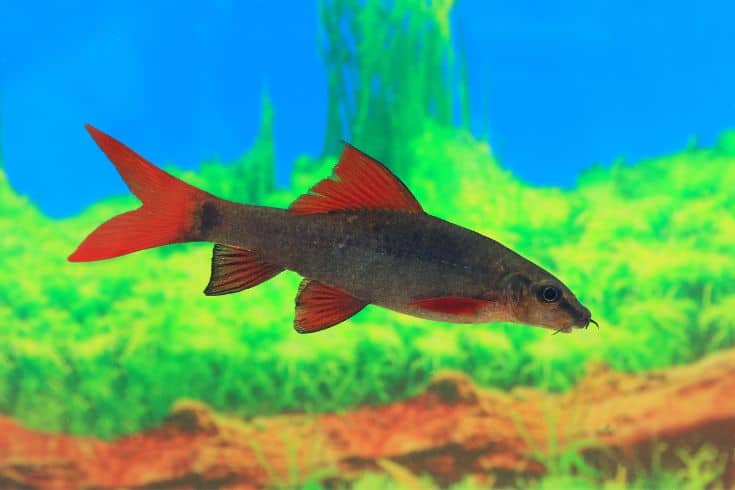
Compatibility and Tankmates
Mature Rainbow sharks are semi-aggressive, territorial fish that can be intolerant of others invading their space. However, as juveniles, these fish are pretty shy creatures that generally hide away from their tank mates.
Rainbow Shark Tank Mates
Rainbow sharks can be kept in community tanks, provided their tank mates prefer to swim in the upper areas of the water column. With that in mind, we recommend avoiding other bottom-dwellers since the sharks will chase and harass them.
The key to keeping the peace is to provide a large tank with plenty of hiding places and never overstock your fish tank. Introducing your shark to your community tank last helps to prevent or reduce territorial behavior.
Good tank mates for Rainbow sharks are Rainbow fish, danios, barbs, gouramis, and guppies.
Are Rainbow Sharks A Schooling Species?
Rainbow sharks are not naturally a schooling species and can be belligerent toward their own kind. In nature, the Rainbow shark is a solitary fish that’s somewhat territorial.
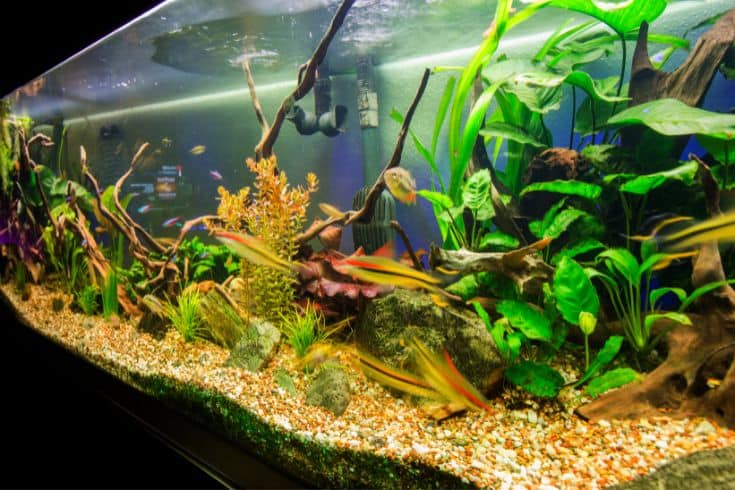
However, if you want to keep more than one of these sharks, you’ll need a very large tank with at least one meter of territory per fish.
Diet and Feeding Habits
What to Feed Your Rainbow Shark
Despite their fearsome reputation, Rainbow sharks are omnivores. In the wild environment, the fish fed on insect larvae, decomposing plants, algae, and zooplankton.
In captivity, Rainbow sharks eat pretty much any of the common fish foods available that reach the bottom of the tank. So, you can feed your fish tropical pellets, fish flakes, frozen food, veggies, and algae wafers.
How Much and How Often to Feed
I recommend feeding your Rainbow shark twice a day, offering only what the fish will consume within a few minutes to avoid overfeeding.
Remember that these fish are scavengers that will graze on leftover food that drifts down from above, as well as graze on any algae they find growing on your plants and aquarium surfaces.
Tank Requirements
Tank Size
Rainbow sharks are active, territorial fish that need lots of swimming space in their tank to live peacefully with their tank mates, so you’ll need at least a 50-gallon tank to house one.
A rectangular tank is the best choice as that provides the swimming area the fish needs as well as more surface area for good gaseous exchange. These agile fish can jump, so a tank with a cover slide or tightly fitting lid is a must.
Tank Setup
Substrate
A soft, sandy substrate replicates the river bottom habitat of the Rainbow shark, although you can use fine gravel if you prefer.
Decoration
Since these Asian freshwater fish are highly territorial, I always add caves, rocky overhangs, clumps of bushy plants, and other natural features that my shark can claim as his own patch.
Habitat Requirements
Filtration
Rainbow Sharks are river dwellers, inhabiting well-oxygenated waters with a medium to fast flow. Ideally, you want to use an external canister filter with a powerhead to replicate those conditions.
Water Parameters
Water Temperature
Rainbow Sharks are tropical species that require a temperature of 75° to 81° F.
Water Hardness and pH Range
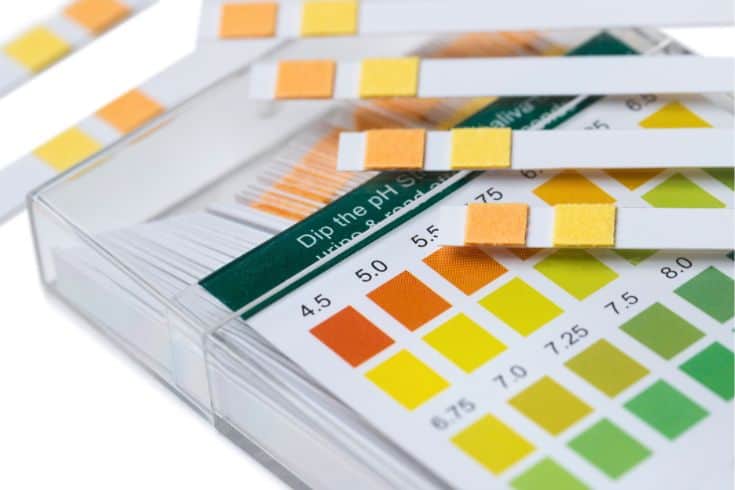
The water should be slightly acidic with a pH of between 6.5 and 7.5 and a water hardness of 5 to 11 dKH.
Lighting
Rainbow sharks have no specific lighting requirements other than a clear day/night cycle, so you can use suitable lights for your plants and provide up to ten hours of light per day for your tank.
Tank Maintenance
Rainbow sharks need pristine, well-oxygenated water to keep them healthy and happy.
So, you’ll need to carry out weekly partial water changes of around 25%, vacuuming the substrate and around the tank bottom thoroughly to remove uneaten fish food, general detritus, and accumulated fish waste.
Use an algae magnet to clean the viewing panes, leaving a few small patches for the fish to graze on.
Rinse filter media in old tank water to remove sludge and keep the water flowing freely through the unit, and replace spent media in line with the manufacturer’s directions.
Setting Up the Fish Tank
Before you begin setting up your fish tank, it’s a good idea to assemble everything you’re going to need.
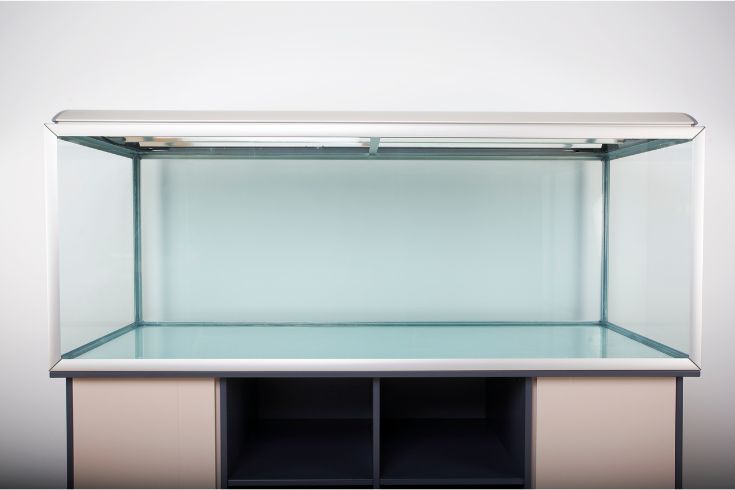
- Rinse the sand or gravel in clean water to remove dust and dirt.
- Add several inches of your chosen substrate to the fish tank.
- Put the heater and filter unit into the tank, but don’t switch them on.
- Fill the aquarium with dechlorinated tap water, pouring the water over an upturned dish to avoid displacing the substrate.
- The water needs to contain ammonia to start the nitrogen cycle in the biological filter media. To do that, you’ll need to add some fish food, a handful of the substrate from a healthy, mature tank, or a couple of drops of pure ammonia to the water.
- Rinse the ornaments to remove dust, and put them into the tank.
- Trim away dead plant leaves and remove any damaged stems. When adding your plants to the tank, remember to allow enough space between them for spread and growth.
- Turn on your filter and heater. Remember that you must have your tank lights on for eight to ten hours daily to allow the plants to photosynthesize.
The tank will take between two weeks and two months to cycle fully. Test the water every couple of days until the ammonia and nitrite levels are zero and nitrates are below 20 ppm. Once that happens, you can introduce a couple of small fish.
Keep testing the water to make sure the levels of harmful chemicals don’t start rising again once the fish have arrived. As long as the water remains clean, you can add a few more fish, taking care not to overcrowd the tank.
Health and Disease

Rainbow Sharks are fairly hardy creatures that remain healthy, provided you give them a nutritious diet, the correct water parameters, and maintain your aquarium correctly.
Signs of Good Health
Rainbow sharks are very active fish that amuse themselves by rooting around on the substrate for scraps and nibbling on algal growth.
Your fish should be quite belligerent to intruders on their territory, chasing them away with an occasional nip.
Red Flags
Here are a few signs that could indicate the onset of one of the common fish ailments affecting most aquarium fish species.
- Loss of appetite
- Inactivity
- Swellings, reddened skin patches, ulcers
- Rubbing or flashing against tank decorations, the substrate, or the tank glass
Common Health Issues and Treatment
Health Issue
Ich (White Spot Disease)
Symptoms or Causes
Ich is a very common disease that’s caused by an aquatic protozoan parasite.
Fish infected with Ich develop a sprinkling of tiny white spots on their fins, gill covers, and bodies. They also flash against the gravel and other solid objects in the aquarium.
Suggested Action
Raise the water temperature to 82o F for three days. Use an OTC White Spot Disease medication to treat the tank.
Health Issue
Flukes
Symptoms or Causes
Flukes is the term used to describe various types of external fish parasites. These macroparasites can often be seen with the naked eye attached to the fish’s skin or gills.
Suggested Action
Treat the fish tank with an OTC antiparasitic medication.
Health Issue
Fungal infections
Symptoms or Causes
White fluffy growths on the fish’s body, mouth, and head.
Suggested Action
Quarantine infected fish, and treat with an antifungal medication.
Health Issue
Bacterial infections
Symptoms or Causes
Sores and ulcers on the body and head, ragged, bloody fins.
Suggested Action
Treat the tank with OTC antibacterial treatment.
Breeding and Reproduction of Rainbow Sharks
Rainbow sharks are sexually mature once the fish reaches 4 inches long or more.
In the wild, the fish generally spawn seasonally in October through November, although that varies, depending on the water temperature and amount of daylight. These fish are egg-layers. Once the female fish has deposited her eggs, the male fertilizes them, and they generally hatch within a week.
Ruby sharks are usually raised on commercial fish farms in Southeast Asia since breeding them in the home tank is pretty much impossible. However, if you have a very large aquarium, you might have a chance of success.
Availability
Rainbow sharks are extremely popular aquarium fish, so you can usually buy them in good fish stores or from online dealers for a few dollars per specimen.
FAQs
In this part of our guide, we answer some of the most commonly asked questions about the beautiful Rainbow shark.

People Also Ask
Q: Are Rainbow sharks aggressive?
A: Rainbow sharks are considered semi-aggressive fish, especially if kept in a small tank. Usually, these fish are peaceful, provided they have plenty of space.
Q: Do Rainbow sharks clean the tank?
A: Rainbow sharks are efficient scavengers that also eat algae off the tank surfaces and plant leaves, helping keep your aquarium clean and tidy.
Q: Does a Rainbow shark have teeth?
A: Rainbow sharks have large mouths and three rows of razor-sharp teeth that the fish use to rip into their prey. However, the fish don’t generally bite people.
Q: Do Rainbow sharks change color?
A: A Rainbow shark’s color can fade as the fish ages or at times when the creature is stressed.
Q: Which is better, a Red Tail or Rainbow shark?
A: Red Tail sharks are more suitable for experienced aquarists than beginners because they tend to be more aggressive than Rainbow sharks, which typically do better in community tanks.
Final Thoughts
Did you enjoy our guide to the enigmatic Rainbow shark? If you found the article interesting, please remember to share it before you go!
Rainbow sharks are large, beautiful fish that can help the aquarist by eating algae, decomposing plant matter, and leftover fish food, keeping the tank tidy.
However, these bottom-dwelling fish are highly territorial and are best kept in a very large tank with plenty of caves, rocky overhangs, and the like that they can claim as theirs. That said, Rainbow sharks can live in a community aquarium with other species that frequent the middle to upper regions of the water column.
What species of tropical shark do you keep? Tell us in the comments box below.
